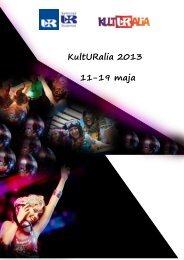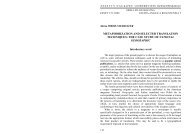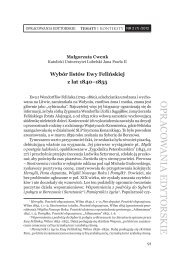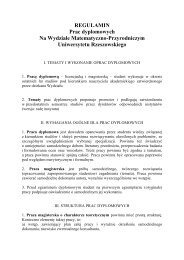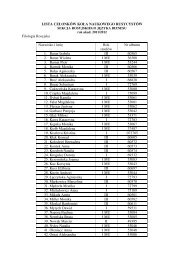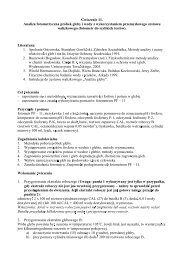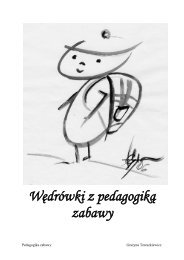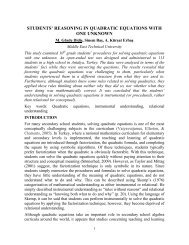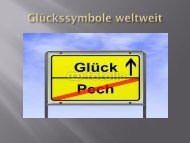the evolution of the western genre resulting from social changes in ...
the evolution of the western genre resulting from social changes in ...
the evolution of the western genre resulting from social changes in ...
You also want an ePaper? Increase the reach of your titles
YUMPU automatically turns print PDFs into web optimized ePapers that Google loves.
that used to be presented <strong>in</strong> black and white symboliz<strong>in</strong>g <strong>the</strong> good and <strong>the</strong> evilare shown <strong>in</strong> a more complex way. For example <strong>the</strong> American soldiers are notthoughtless brutes but imperfect human be<strong>in</strong>gs. Costner tried to make <strong>the</strong> film asau<strong>the</strong>ntic as possible and cast only Native Americans as Indians. The Siouxspeak Lakota language and a full wolf is used for Two Socks.ConclusionThe Western represents adventure, achievement, optimism for <strong>the</strong> future, <strong>the</strong>beauty <strong>of</strong> <strong>the</strong> land, and <strong>the</strong> courage <strong>of</strong> <strong>the</strong> <strong>in</strong>dividuals who won <strong>the</strong> land. Theclassic <strong>western</strong> can be an allegory <strong>of</strong> <strong>the</strong> fight between good and evil. Americanvalues – <strong>in</strong>dividualism, self-reliance and equality <strong>of</strong> opportunity – were allpresent <strong>in</strong> both <strong>the</strong> frontier life and <strong>western</strong>s. Movie-makers used <strong>western</strong>s tocomment on historical and political events. The analysis <strong>of</strong> <strong>the</strong> historicalbackground and <strong>the</strong> <strong>changes</strong> <strong>of</strong> <strong>the</strong> American society prove <strong>the</strong>re is a connectionbetween <strong>the</strong> society and <strong>the</strong> <strong>western</strong>. Along with <strong>the</strong> <strong>changes</strong> <strong>of</strong> Americansociety <strong>the</strong> <strong>western</strong> <strong>genre</strong> underwent transformations as well. With <strong>the</strong>development <strong>of</strong> new perceptions some issues were presented <strong>in</strong> a different way.Especially <strong>the</strong> image <strong>of</strong> Native Americans was completely revised as Americansbecame more sensitive towards ethnic m<strong>in</strong>orities – <strong>the</strong> ‘o<strong>the</strong>rs.’ Beh<strong>in</strong>d <strong>the</strong>simple plot and <strong>the</strong> characters <strong>the</strong>re is a hidden message. The function <strong>of</strong> <strong>the</strong>Western is to provide <strong>the</strong> vehicle for our dreams, s<strong>in</strong>ce <strong>in</strong> most cases we havesettled on our realities. (Fen<strong>in</strong> 1962:341)ReferencesBooksBaz<strong>in</strong>, A. 2004. What is c<strong>in</strong>ema? Vol. II, (translated by Hugh Gray). Berkeley: University <strong>of</strong>California Press.Fen<strong>in</strong>, G.N. and W.K. Everson 1962. The Western, <strong>from</strong> Silents to C<strong>in</strong>erama. New York: BonanzaBooks.Gobiowski, M. 2004. Dzieje Kultury Stanów Zjednoczonych. Warszawa: Wydawnictwo NaukowePWN.Skwara, J. 1985. Western odrzuca legend. Warszawa: Modzieowa Agencja Wydawnicza.ArticlesGarbowski, Ch. 2006. „John Ford. Cigo i poszukiwanie” [<strong>in</strong>:] K<strong>in</strong>o Amerykaskie. Twórcy,E. Durys and K. Klejsy (eds), Kraków: Rabid, pp. 49–72.Kolasiska-Pasterczyk, I. 2007. “Arthur Penn – odkamywanie Ameryki” [<strong>in</strong>:] Mistrzowie K<strong>in</strong>aAmerykaskiego, .A. Plesnar and R. Syska (eds), Kraków: Rabid, pp. 185–208.66



